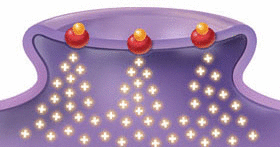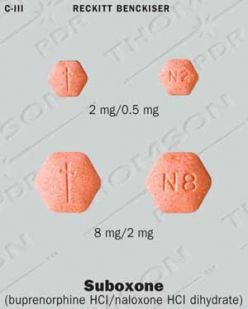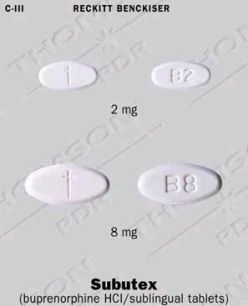Medications used in treatment
Buprenorphine
- Opioid receptor is empty -- As someone becomes tolerant to opioids, they become less sensitive and require more opioids to produce the same effect. Whenever there is an insufficient amount of opioid receptors activated, the patient feels discomfort. This happens in withdrawal.
- Opioid receptor satisfied with a full-agonist opioid -- The strong opioid effect of heroin and painkillers can cause euphoria and stop the withdrawal for a period of time (4-24 hours). The brain begins to crave opioids, sometimes to the point of an uncontrollable compulsion (addiction), and the cycle repeats and escalates.
- Opioids replaced and blocked by buprenorphine -- Buprenorphine competes with the full agonist opioids for the receptor. Since buprenorphine has a higher affinity (stronger binding ability) it expels existing opioids and blocks others from attaching. As a partial agonist, the buprenorphine has a limited opioid effect, enough to stop withdrawal but not enough to cause intense euphoria.
- Over time (24-72 hours) buprenorphine dissipates -- but still creates a limited opioid effect (enough to prevent withdrawal) and continues to block other opioids from attaching to the opioid receptors.
- A tablet containing buprenorphine and naloxone
- Buprenorphine triggers an effect similar to heroin or morphine but weaker
- The naloxone triggers harsh withdrawals if the drug is injected rather than properly ingested
- Comes in two dosage forms: 2 mg buprenorphine/0.5 mg naloxone and 8 mg buprenorphine/2 mg naloxone.
- Eliminates the relationship with opioids
- Does not cause tolerance or dependance
- Causes withdrawal symptoms if the patient is opioid-dependant for about two hours
- Weaker than heroin and longer lasting
- Forms oral tablets for daily dose and “take home” for weekends or away
- Developed in Germany during WWII when German army was unable to obtain morphine
- Legal as a substitute for opioids in medical treatment programs (methadone maintenance)
- Administered by a patch and as a pill
- Can cause hypotension and sedation, so monitoring of blood pressure is essential
- Can also be administered during rapid detox
- Takes 6-8 hours
- Performed under anesthesia
Buphenorphine doesn't heal or cure opioid addiction; it helps treat and manage it and is used for long term maintenance.
Subutex/Suboxone:

 Subutex is a Schedule III drug used to treat opium users, introduced in 2002. Naloxone was added to create Suboxone after users began to crush and inject the drug for a high. Injected naloxone first removes opiates from their receptors, then acts as a competetive antagonist, triggering violent withdrawals but preventing the user from getting high. Subutex is given during the first few days of treatment, while Suboxone is used during the maintenance phase.
Subutex is a Schedule III drug used to treat opium users, introduced in 2002. Naloxone was added to create Suboxone after users began to crush and inject the drug for a high. Injected naloxone first removes opiates from their receptors, then acts as a competetive antagonist, triggering violent withdrawals but preventing the user from getting high. Subutex is given during the first few days of treatment, while Suboxone is used during the maintenance phase.
Naloxone/Narcan:
Narcan is a hydrochloridal injection that blocks the acute onset of withdrawal symptoms. Narcan is a pure agonist, and in regular doses has no pharmacologic activity without the presence of opioids.
Methadone
Methadone is prescribed to relieve pain that non-narcotic analgesics have had no effect on, and to prevent withdrawal symptoms.
Others
Clonidine:
Clonidine is generally taken orally for the first two days on the patch, as the medication can take some time to travel through the skin. It primarily reduces anxiety, agitation, muscle aches, sweating, runny nose and cramping during withdrawl from opioids.
Rapid detox:
During rapid detox, a combination of drugs (often naltrexone and clonidine) are administered to a patient. Lofexidine can also be used to help relieve withdrawal symptoms.
There is no evidence that these programs actually reduce the time spent in withdrawal. In some cases, they may reduce the intensity of symptoms. However, there have been several deaths associated with the procedures, particularly when it is done outside a hospital. Because opiate withdrawal produces vomiting, and vomiting during anesthesia significantly increases death risk, many specialists think the risks of this procedure significantly outweigh the potential (and unproven) benefits.